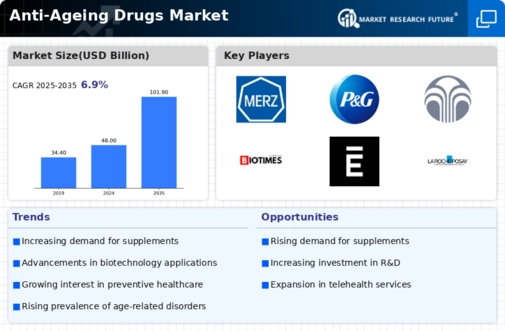Anti Ageing Drugs Market Summary
As per Market Research Future Analysis, the Global Anti-Ageing Drugs Market was valued at USD 47.90 billion in 2024 and is projected to reach USD 100.00 billion by 2035, growing at a CAGR of 6.92% from 2025 to 2035. The market growth is driven by the increasing ageing population, rising disposable incomes, and heightened awareness of anti-aging products. The serums and supplements segment dominated the market in 2022, attributed to consumer awareness regarding age-related skin issues. North America holds the largest market share, followed by Europe and Asia-Pacific, with significant growth expected in the UK and India.
Key Market Trends & Highlights
The anti-ageing drugs market is witnessing significant growth due to various factors.
- The elderly population is expected to double by 2050, reaching 22% of the global population.
- Skincare products accounted for 41% of the global anti-ageing market in 2021.
- North America is the largest market, driven by high disposable income and awareness of ageing signs.
- The Asia-Pacific region is anticipated to grow steadily, with China leading in market share.
Market Size & Forecast
| 2024 Market Size | USD 47.90 Billion |
| 2035 Market Size | USD 100.00 Billion |
| CAGR (2024-2035) | 6.92% |
Major Players
Key companies include Merz Pharma (Germany), Procter & Gamble (US), Nu Skin (US), BIOTIME Inc (US), Elysium Health Inc (US), La Roche-Posay (UK), DermaFix (South Africa), L’Oreal (France), Estee Lauder Inc (US), and Oriflame Cosmetics (Switzerland).




















Leave a Comment